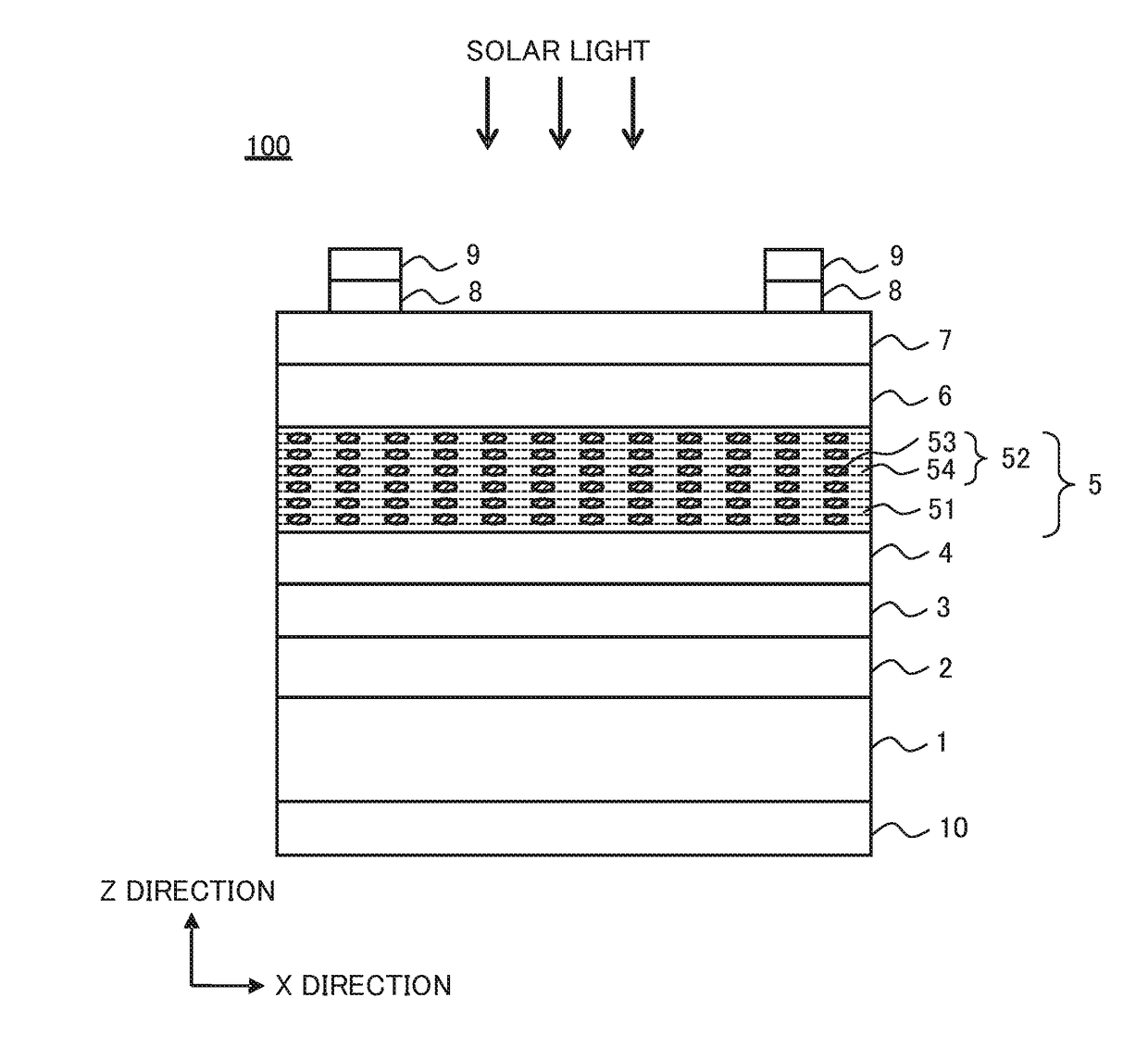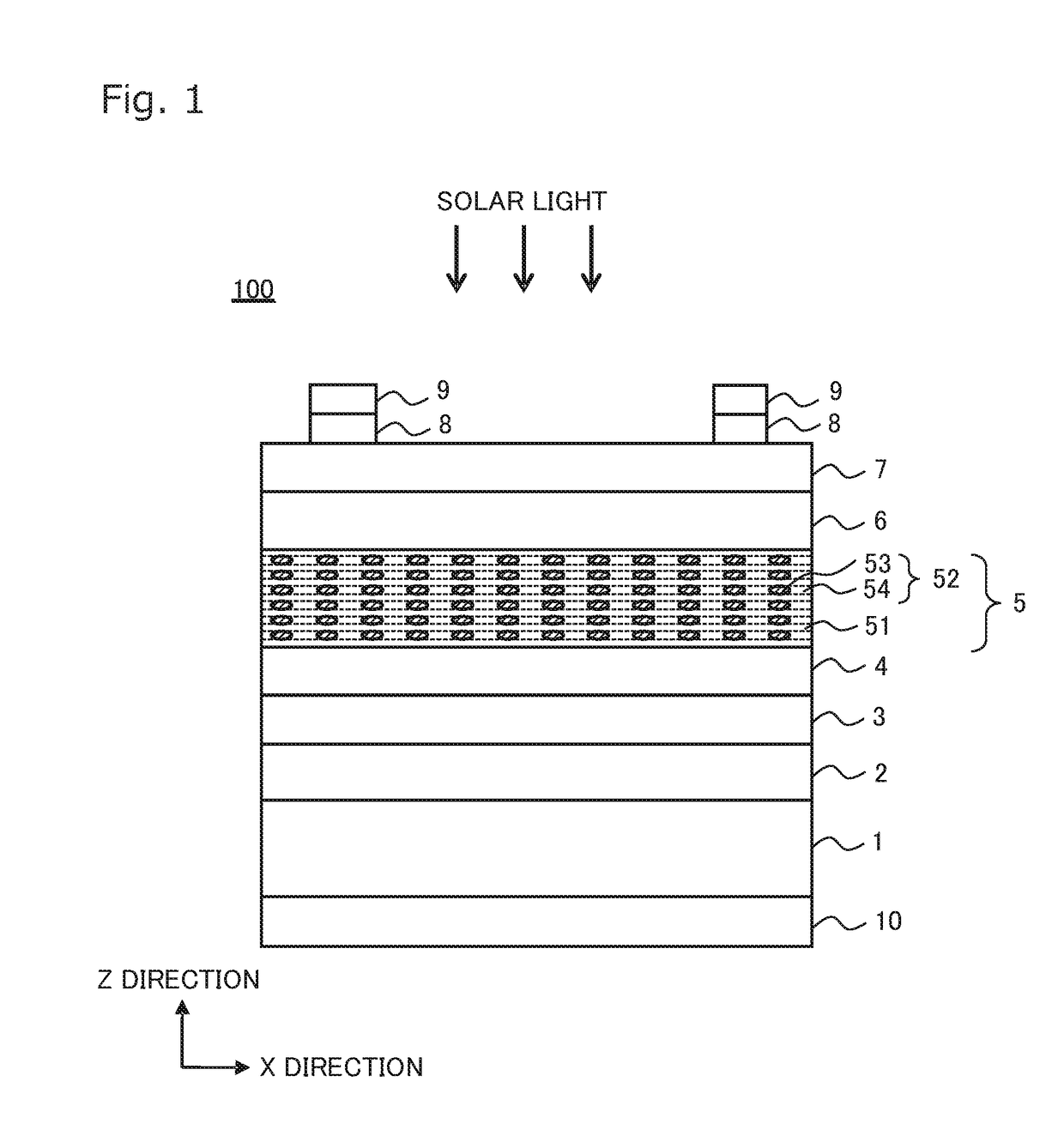Photoelectric conversion element having quantum structure using indirect transition conductor material
a photoelectric conversion element and transition conductor technology, applied in the field of photoelectric conversion elements, can solve the problems of low efficiency of two-step light absorption through quantum levels, low efficiency, and the problem of increasing sensitivity of quantum dot photosensors, etc., and achieve the effect of improving the efficiency of photoelectric conversion, sluggish improvement of photoelectric conversion efficiency, and low efficiency of two-step light absorption
- Summary
- Abstract
- Description
- Claims
- Application Information
AI Technical Summary
Benefits of technology
Problems solved by technology
Method used
Image
Examples
embodiment
[0022]An embodiment of the present disclosure is described in detail below with reference to the drawings. The same portion or corresponding portions are denoted by the same reference numeral, and description thereof is not repeated. In order to make the description easy to understand, the drawings referred to below each show a simplified or illustrated configuration, or some of the constituent members are omitted. Also, the dimensional ratio between the constituent members shown in each of the drawings is not necessarily an actual dimensional ratio.
[0023]The terms used in the specification are briefly described here. However, the terms are described with respect to a configuration of the embodiment, and the present disclosure is not limited to the description of the terms.
[0024]The term “quantum layer” represents a quantum dot layer, a quantum nanowire layer, a quantum well layer, or the like, which includes a semiconductor material having a narrower bandgap than that of the semico...
experimental example 1
[0085]In a superlattice semiconductor layer 5 of Experimental Example 1, aluminum gallium arsenide (Al0.8Ga0.2As) was used as a base semiconductor material constituting a barrier layer 51, and indium arsenide (InAs) was used as a material of quantum dots 53. Al0.8Ga0.2As is an indirect transition semiconductor material having a bandgap at room temperature of 2.54 eV at a Γ point and 2.10 eV at an X point. That is, the bandgap at room temperature is more than 1.42 eV. InAs is a direct transition semiconductor having a bandgap at room temperature of 0.35 eV at a Γ point.
[0086]In the experimental example, AlGaAs was used as the base semiconductor material of the barrier layer 51, and InAs was used as a material of the quantum dots 53a. However, mixed crystal materials such as AlInGaAs, InGaAs, and the like, materials having different compositions, different semiconductor materials, or the like may be used.
[0087]The shape of the quantum dots 53 was a lens shape containing a wetting laye...
experimental example 2
[0096]In Experimental Example 2, the same simulation experiment as in Experimental Example 1 was performed except that in the superlattice semiconductor layer 5 used in Experimental Example 1, the size (height) of the quantum dots 53 in the stacking direction was 1.3 nm, and the distance between the quantum dots 53 in the stacking direction was 4 nm.
[0097]In a configuration of a superlattice semiconductor layer 5, aluminum gallium arsenide (Al0.8Ga0.2As) was used as a base semiconductor material constituting a barrier layer 51, and indium arsenide (InAs) was used as a material of quantum dots 53. Al0.8Ga0.2As is an indirect transition semiconductor material having a bandgap at room temperature of 2.54 eV at a Γ point and 2.10 eV at an X point. That is, the bandgap at room temperature is more than 1.42 eV. InAs is a direct transition semiconductor having a bandgap at room temperature of 0.35 eV at a Γ point.
[0098]In Experimental Example 2, AlGaAs was used as the base semiconductor ma...
PUM
 Login to View More
Login to View More Abstract
Description
Claims
Application Information
 Login to View More
Login to View More - R&D
- Intellectual Property
- Life Sciences
- Materials
- Tech Scout
- Unparalleled Data Quality
- Higher Quality Content
- 60% Fewer Hallucinations
Browse by: Latest US Patents, China's latest patents, Technical Efficacy Thesaurus, Application Domain, Technology Topic, Popular Technical Reports.
© 2025 PatSnap. All rights reserved.Legal|Privacy policy|Modern Slavery Act Transparency Statement|Sitemap|About US| Contact US: help@patsnap.com



